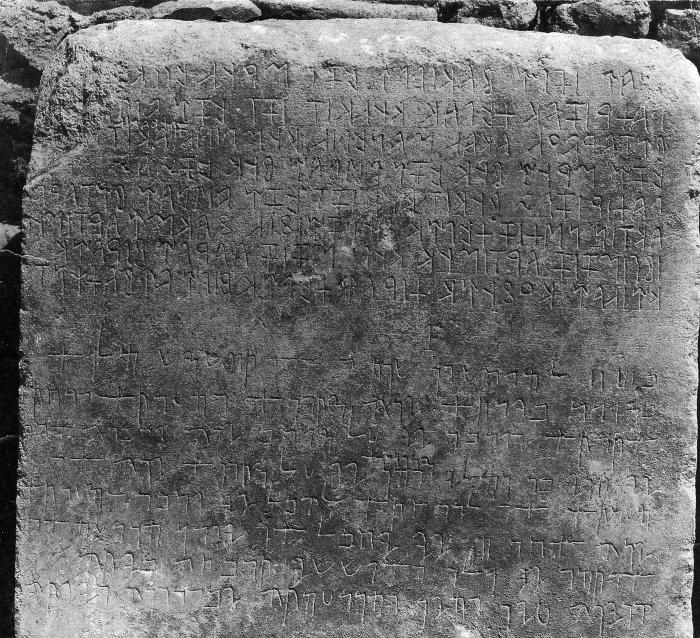Lidya-Aramca İki Dilli Yazıtlı Marş
- Dönem
- 394 BC, Geç Lidya (Pers)
- Müze
- İzmir, Arkeoloji Müzesi, 691
- Müze Envanter No.
- 691
- Sardeis veya Müze Env. No.
- Izmir 691
- Malzeme
- Mermer, Taş
- Eserin Türü
- Heykel
- Heykelin Türü
- Stel
- Yerleşim
- Sardis
- Alan (Sektör)
- Nec
- Locus
- Nec Wall with Lydian Stelai
- Bulunduğu Yeri
- Found May 20, 24, 1912, in thick low wall "on the northern slope of the Nekropolis hill west of the Paktolos, about 40 m. above the ravine which faced the 'Stele tomb' [see Sardis I, 116] and about 15 m above that tomb. In the same wall were embedded our nos. 2, 5, 6, 8, 9, 10, 11, 13, 17, 18, and 19" (Sardis VI, 2, 1, with sketch plan of the terrace -- Roman? Byzantine? -- which was removed by excavators in 1912). Original location unknown.
- Tanım
Two vertical half-volutes grow out of small acanthus chalices to support a seven-leaf simple palmette. Two small flowers (or ears of corn?) flank the central petal. Three large downward-pointed chalices are in the center below the palmette. Below the volutes on each side are three flaming palmette type leaves. Rising up to that height on each side was a vertical flower with bell-like blossom. The general shape is a tall oval. On a simple projecting profile at the top of the shaft is a base band. The finial itself had a raised frame.
Conservative features (wide spirals, simple palmette) and advanced ones (flaming palmette, acanthus, added bell-flowers) are mixed, but the striking resemblance to the bell-flowers of the frieze from the monument to the Corinthian war of 394 B.C. (Möbius, Ornamente Grabstelen 1929, 24, n. 25, pl. 9d) would suffice to determine a date of ca. 400 B.C. for the stele, which is confirmed by the other features (e.g. palmette rather like Erechtheion).
The following translation is taken from Gusmani's German:
( . . . . . ) in the ending (?) Month of Bakkhos. This stele and this (grave chamber)/ and the dromos (?) and the area and whatever to this grave chamber/ belongs, now that (is) of Maneś (the son of) Kumliś, (the grandson?) of Silukas; now whosoever/ this stele or this grave chamber of this/ dromos or whatever belongs to this grave chamber/ now whoever something damages, to him Artemis/ of Ephesus and Artemis of Koloe to (his) court and house, to earth and water, to his possession and whatever it may be, shall bring destruction.
The meaning is assured by the Aramaic version. It is the Aramaic text which gives the date, "on the fifth of Marhesuan, of year 10 of Artaxerxes the King, in Sardis, the fortress." Only the month survives in the Lydian text.
The stele is dated to the tenth year of an Artaxerxes. There are three possible Artaxerxes with tenth years to their reigns, 455 B.C., 394 B.C., and 349 B.C.; only 394 B.C., Artaxerxes II, is possible on the grounds of style. Aramaic scholars tend to accept this date; Lydian scholars, according to Gusmani, Lydisches Worterbuch, 18, favor 349 B.C.; Gusmani, Lydiaka, 272, now opts for 394. Neither epigraphy permits closer dating than the Greek ornament, for which datable evidence is particularly good in the later 5th and 4th C. B.C.
- Condition
Marble.
Condition as found, from Sardis VI, 2, 1: In two pieces. Upper piece: broken only at bottom (H. 0.80; W. 0.53; Th. 0.165), the sculptured anthemion being 0.63 in H., while the shaft below is 0.17 H. The lower piece: broken across top, in I. upper corner, and at bottom (H. 0.83; W. 0.46, at top; Th. 0.15). It consists of a chipped portion 0.028 H. Below this is a smooth surface (H. 0.375) bearing the Lydian text (above) and Aramaic (below), and at the bottom an uninscribed surface (H. 0.42). The Lydian letters are 0.018 to 0.006; Aramaic 0.021 to 0.008. According to R. Gusmani (1970) inscription has become nearly unreadable. Preservation of finial: damaged on r. side; I. side complete but part of background broken off.
- Yorum
- Ayrıca bakınız
- Kaynakça
- Published: Sardis I, 117f., figs. 123, 179 (finial complete); Sardis VI, 1, 23ff., L. 17, pl. 1, inscription. Sardis VI, 2, 1ff., no. 1, location sketch and p. 2 fig., both parts of stele; pl. 1, inscription. Möbius, Ornamente Grabstelen 1929, 24, n.16, pl. 9c. Gusmani, Lydisches Worterbuch, 250, no. 1; idem, Lydiaka, 272. Aramaic inscription: Sardis VI, 1, 3ff.; P. Kahle and F. Sommer, Bilingue, with previous bibliography; Donner-Röllig, Inschriften, 305-309, no. 260. R.S. Hanson, Aramaic Funerary Inscriptions 192, 7-9, on borrowings from Persian.
- Yazar
- NHR

